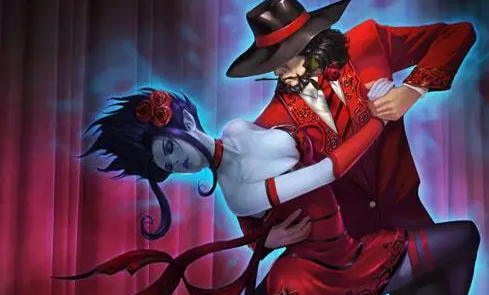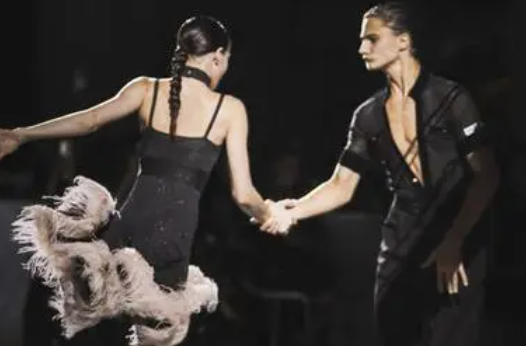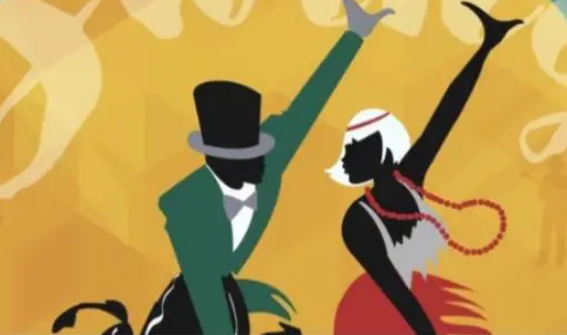拉丁舞术语摆荡
导读:拉丁舞是一种富有热情和活力的舞蹈形式,起源于拉丁美洲地区。无论是在夜总会还是舞蹈比赛中,拉丁舞总能吸引人们的目光。对于初学者来说,拉丁舞的术语可能会让人摸不着头脑。本文将
拉丁舞是一种富有热情和活力的舞蹈形式,起源于拉丁美洲地区。无论是在夜总会还是舞蹈比赛中,拉丁舞总能吸引人们的目光。对于初学者来说,拉丁舞的术语可能会让人摸不着头脑。本文将带领读者了解一些常见的拉丁舞术语,让你在跳舞时能够更加得心应手。
一、“舞态”:姿势决定舞步的美感
拉丁舞中的“舞态”是指舞者的身体姿势和动作,它决定了舞步的美感和舞蹈的表现力。在拉丁舞中,舞者通常需要保持身体挺直,背部直立,头部抬起,肩部放松,胸部推出,腹部收紧。这样的舞态能够让舞者在跳舞时显得更加优雅和自信。
【举例】在跳桑巴舞时,舞者的舞态应该保持挺胸抬头、腹部紧绷,臀部稍微向后倾,让身体呈现出S型曲线。这样的舞态能够让舞者在跳舞时更加动感十足。
二、“音乐节奏”:顺应节奏的关键
拉丁舞非常注重与音乐的配合,舞者需要根据音乐的节奏和速度来进行舞蹈动作。这就需要舞者具备良好的音乐感和节奏感,能够准确地把握音乐的节拍和强弱。只有顺应音乐的节奏,舞者才能更好地展现出拉丁舞的热情和活力。
【举例】在跳恰恰舞时,舞者需要根据快速的古巴音乐,以四拍为一个循环,快速踏步、摆动臀部,并结合跳跃和抛摆等动作,展现出舞步的独特魅力。
三、“协调性”:舞伴默契的重要基础
拉丁舞通常是由两个人共同完成的,舞者之间的默契和协调性是确保舞蹈顺利进行的重要基础。舞伴之间需要时刻保持彼此的沟通和配合,这包括通过眼神、手势和身体语言来交流,以便顺利完成各种舞蹈动作和转身。
【举例】在跳探戈舞时,男舞者需要通过细微的引导和领舞,使女舞者能够准确地感受到舞蹈的方向和节奏,并在转身时保持平衡和协调。这样的舞伴默契能够让整个舞蹈更加流畅和优美。
四、“舞韵”:舞者展现个人风格的重要方式
每个舞者都有自己独特的舞蹈风格和表达方式,这被称为“舞韵”。舞韵是指舞者在跳舞时通过身体的表现、手势和面部表情来展现自己的个性和情感。不同的舞者可能会有截然不同的舞韵,这也是拉丁舞如此多样化和有趣的地方。
【举例】在跳伦巴舞时,舞者通常会以慢悠悠的节奏展现出浪漫和柔情的舞韵。女舞者可能会展开自己的舞裙,用手部动作和身体摇摆来表达自己的情感,而男舞者则会以绅士风度引导女舞者进行舞蹈。
五、“比赛规则”:强化舞者技巧的竞争平台
拉丁舞比赛是展示舞者技巧和舞蹈风格的重要平台。在比赛中,舞者需要按照规定的舞步和舞姿进行表演,并按照评委的评分标准来获得成绩。比赛规则的存在既对舞者的技巧水平提出了要求,又能够增加比赛的公平性和可比性。
【举例】在拉丁舞比赛中,舞者的技巧、舞态、舞韵和与舞伴的默契度都是评委们评分的重点。评委们会根据舞者的表现给予相应的分数,并评选出优胜者。比赛的结果不仅能够激励舞者继续努力,还能够为观众带来精彩的舞蹈表演。
拉丁舞术语虽然多样且复杂,但只要通过学习和实践,就能够逐渐掌握并运用于舞蹈中。舞态、音乐节奏、协调性、舞韵和比赛规则,这些是拉丁舞中的关键要素。通过了解这些术语,相信你已经对拉丁舞有了更深入的认识和理解,希望你能够在舞蹈的世界中尽情展现自己的魅力!
拉丁舞术语中英文对照
Introduction:

Latin dance is a vibrant and energetic form of dance that originated in Latin America. With its rhythmic movements and captivating music, it has gained popularity worldwide. To better understand and appreciate Latin dance, it is essential to familiarize ourselves with its terminology. In this article, we will explore some common Latin dance terms, providing both their English translations and explanations.
Part 1: Basic Steps
1. Forward Basic (Adelante): The most fundamental step in Latin dance, where the dancer moves forward, starting with the left foot.
2. Back Basic (Atrás): The opposite of the forward basic, with the dancer moving backward, starting with the right foot.
3. Side Basic (Lateral): A step to the side, usually done with a slight hip movement. It can be performed to the left or right.
Part 2: Turns and Spins
1. Spot Turn (Giro): A turn where the dancer rotates on the spot without traveling. It is executed by pivoting on one foot while keeping the other foot close.
2. Spiral Turn (Espiral): A dynamic turn where the dancer moves in a spiral pattern, creating a sense of fluidity and grace.
3. Spin (Vuelta): A fast rotation executed by turning on one foot and keeping the other leg extended. Spins can be single, double, or multiple, depending on the number of rotations.
Part 3: Partnerwork
1. Cross Body Lead (Dile Que No): A basic partner move where the leader and follower exchange their positions by crossing in front of each other.
2. Cuban Motion (Ritmica Cubana): The characteristic hip movement in Latin dance, where the pelvis moves in a figure-eight motion.
3. Underarm Turn (Paseala): A turn where the follower turns under the leader's raised arm, creating an elegant and flowing movement.
Part 4: Latin Dance Styles
1. Salsa: A popular and lively dance style that incorporates elements of Afro-Cuban and Puerto Rican music. It is characterized by fast footwork, intricate turns, and syncopated rhythms.
2. Bachata: A sensual dance style that originated in the Dominican Republic. It is characterized by its hip movements, close embrace, and syncopated rhythms.
3. Cha-Cha-Cha: A lively dance style that originated in Cuba. It is known for its quick footwork, syncopated steps, and playful hip movements.
Part 5: Performance Techniques
1. Body Isolation: The ability to move different parts of the body independently, creating contrast and dynamic movements.
2. Musicality: The ability to interpret and dance in sync with the music by accentuating specific beats or melodies.
3. Styling: The individual dancer's personal expression and embellishments added to the basic steps, making the dance unique and captivating.
Conclusion:
Mastering the language of Latin dance is crucial for dancers and enthusiasts alike. By understanding the terminology and its meanings, we can deepen our appreciation for the art form. Whether you're a beginner or an experienced dancer, these English translations of Latin dance terms will surely enhance your understanding and enjoyment of this lively dance style. So, let's put on our dancing shoes and explore the world of Latin dance together!
拉丁舞摆荡是哪个动作
一、拉丁舞摆荡的起源

拉丁舞摆荡,起源于拉丁美洲,是一种充满激情和活力的舞蹈形式。这种舞蹈起源于20世纪初的古巴,受到了非洲和西班牙文化的影响。拉丁舞摆荡的起源可以追溯到古巴哈瓦那的夜总会,当时的古巴因其独特的音乐和舞蹈而闻名。
二、拉丁舞摆荡的基本动作
拉丁舞摆荡的基本动作包括扭摆、龙蛇摆动和脚步变化等。扭摆是拉丁舞摆荡的核心动作之一,它是以臀部为中心进行的扭动动作,既显示了身体的柔韧性,又增加了舞蹈的动感。龙蛇摆动则是拉丁舞摆荡中的另一个重要动作,通过对身体的连续起伏和摆动来表达舞者的情感。脚步变化也是拉丁舞摆荡的特点之一,舞者通过不同的步法和节奏来展示自己的技巧和魅力。
三、拉丁舞摆荡的舞步变化
在拉丁舞摆荡中,舞者可以通过改变步法和舞姿来展示自己的风格。舞者可以使用快速的脚步和连贯的动作来展示自己的技术和灵活性。舞者还可以通过扭动躯干和旋转身体来表达自己的情感和个性。这些舞步变化使得拉丁舞摆荡充满了变化和吸引力。
四、拉丁舞摆荡的表演技巧
在拉丁舞摆荡的表演中,舞者需要具备一定的技巧和表现力。舞者需要具备良好的身体控制能力,能够通过扭动和摆动身体来表达自己的情感。舞者需要具备良好的节奏感和音乐理解能力,能够与音乐完美地协调和配合。舞者还需要具备良好的舞台表现能力,能够通过舞姿和表情来吸引观众的注意力。
五、拉丁舞摆荡的流行程度
拉丁舞摆荡在全球范围内都非常受欢迎,成为了一种流行的舞蹈形式。拉丁舞摆荡不仅在舞蹈比赛和表演中广泛出现,也成为了人们休闲娱乐和健身的选择。其独特的风格和动感使得拉丁舞摆荡成为了一种深受大众喜爱的舞蹈形式。
通过上述五个部分的介绍,我们对于拉丁舞摆荡这个题目有了一个全面的了解。从拉丁舞摆荡的起源到基本动作、舞步变化,再到表演技巧和流行程度,我们可以看到拉丁舞摆荡是一种充满激情和活力的舞蹈形式,吸引了许多人的关注和喜爱。无论是作为一种艺术形式还是一种娱乐方式,拉丁舞摆荡都在舞台上展现了自己的魅力。无论你是舞者还是观众,拉丁舞摆荡都会给你带来无尽的好处和享受。


















